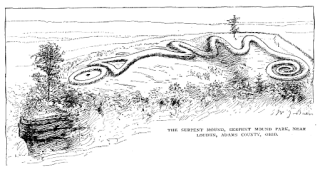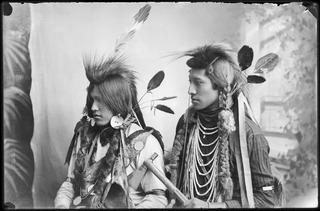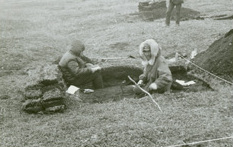 W
WThis list of pre-Columbian cultures includes those civilizations and cultures of the Americas which flourished prior to the European colonization of the Americas.
 W
W1493: Uncovering the New World Columbus Created is a nonfiction book by Charles C. Mann first published in 2011. It covers the global effects of the Columbian Exchange, following Columbus' first landing in the Americas, that led to our current globalized world civilization. It follows on from Mann's previous book on the Americas prior to Columbus, 1491: New Revelations of the Americas Before Columbus.
 W
WNorth American archaeological periods divides the history of pre-Columbian North America into a number of named successive eras or periods, from the earliest-known human habitation through to the early Colonial period which followed the European colonization of the Americas.
 W
WThe Great Osage Trail, also known as the Osage Trace or the Kaw Trace was one of the more well-known Native American trails through the countryside of what are today called the Midwest and Plains States of the U.S., pathways originally created by herds of Buffalo or other migrating wildlife.
 W
WThis is a chronological list of significant or pivotal moments in the development of Native American art or the visual arts of the Indigenous peoples of the Americas. Earlier dates, especially before the 18th century, are mostly approximate.
 W
WAztec philosophy was a school of philosophy that developed out of Aztec culture. The Aztecs had a well-developed school of philosophy, perhaps the most developed in the Americas and in many ways comparable to Ancient Greek philosophy, even amassing more texts than the ancient Greeks. Aztec cosmology was in some sense dualistic, but exhibited a less common form of it known as dialectical monism. Aztec philosophy also included ethics and aesthetics. It has been asserted that the central question in Aztec philosophy was how people can find stability and balance in an ephemeral world.
 W
WBeluga Point Site (49ANC-054) is an archaeological location along Turnagain Arm of Cook Inlet, near Seward Highway Milepost 110, south of Anchorage, in the U.S. state of Alaska. It was added to the National Register of Historic Places on March 30, 1978.
 W
WThe Bureau of American Ethnology was established in 1879 by an act of Congress for the purpose of transferring archives, records and materials relating to the Indians of North America from the Interior Department to the Smithsonian Institution. But from the start, the bureau's visionary founding director, John Wesley Powell, promoted a broader mission: "to organize anthropologic research in America." Under Powell, the bureau organized research-intensive multi-year projects; sponsored ethnographic, archaeological and linguistic field research; initiated publications series ; and promoted the fledgling discipline of anthropology. It prepared exhibits for expositions and collected anthropological artifacts for the Smithsonian United States National Museum. In addition, the BAE was the official repository of documents concerning American Indians collected by the various US geological surveys, especially the Geographical and Geological Survey of the Rocky Mountain Region and the Geological Survey of the Territories. It developed a manuscript repository, library and illustrations section that included photographic work and the collection of photographs.
 W
WIndigenous Canadians are the indigenous peoples within the boundaries of Canada. They comprise the First Nations, Inuit and Métis. Although "Indian" is a term still commonly used in legal documents, the descriptors "Indian" and "Eskimo" have somewhat fallen into disuse in Canada, and some consider them to be pejorative. "Aboriginal" as a collective noun is a specific term of art used in some legal documents, including the Constitution Act, 1982, though in some circles that word is also falling into disfavour.
 W
WThe cacicazgos were major chieftainships of the Taíno on the island of Ayiti/Quisqueya spain named it (Hispaniola)]], leading to them being called the Chiefdoms of Hispaniola or the Cacicazgos of Ayiti. These chiefdoms—or cacicazgos, as found and named by the Spanish settlers in the early Columbian era—were governed by Taíno chiefs called "caciques".
 W
WThe Council of the Indies; officially, the Royal and Supreme Council of the Indies, was the most important administrative organ of the Spanish Empire for the Americas and the Philippines. The crown held absolute power over the Indies and the Council of the Indies was the administrative and advisory body for those overseas realms. It was established in 1524 by Charles V to administer "the Indies," Spain's name for its territories. Such an administrative entity, on the conciliar model of the Council of Castile, was created following the Spanish conquest of the Aztec empire in 1521, which demonstrated the importance of the Americas. Originally an itinerary council that followed Charles V, it was subsequently established as an autonomous body with legislative, executive and judicial functions by Philip II of Spain and placed in Madrid in 1561. The Council of the Indies was abolished in 1812 by the Cortes of Cádiz, briefly restored in 1814 by Ferdinand VII of Spain, and definitively abolished in 1834 by the regency, acting on behalf of the four-year-old Isabella II of Spain.
 W
WGreat Father and Great Mother were titles used by European colonial powers in North America along with the United States during the 19th century to refer to the U.S. President, the King of Great Britain, the King of Spain, or the King of France during interactions with indigenous peoples. Contrary to depictions in popular culture, there are no recorded instances of the terms "Great White Father" being used to refer to the U.S. president. The addition of the word "white" may have entered popular lexicon via western adventure novels.
 W
WThe Handbook of North American Indians is a series of edited scholarly and reference volumes in Native American studies, published by the Smithsonian Institution beginning in 1978. Planning for the handbook series began in the late 1960s and work was initiated following a special congressional appropriation in fiscal year 1971. To date, 15 volumes have been published. Each volume addresses a subtopic of Americanist research and contains a number of articles or chapters by individual specialists in the field coordinated and edited by a volume editor. The overall series of 20 volumes is planned and coordinated by a general or series editor. Until the series was suspended, mainly due to lack of funds, the series editor was William C. Sturtevant, who died in 2007.
 W
WIndian Givers: How the Indians of the Americas Transformed the World is a 1988 non-fiction book by American author Jack Weatherford. The book explains the many ways in which the various peoples native to North and South America contributed to the modern world's culture, manufacturing, medicine, markets, and other aspects of modern life.
 W
WThe Indian Reorganization Act (IRA) of June 18, 1934, or the Wheeler–Howard Act, was U.S. federal legislation that dealt with the status of American Indians in the United States. It was the centerpiece of what has been often called the "Indian New Deal". The major goal was to reverse the traditional goal of cultural assimilation of Native Americans into American society and to strengthen, encourage and perpetuate the tribes and their historic Native American cultures in the United States.
 W
WThe indigenous peoples of the North American Southwest are those in the current states of Colorado, Arizona, New Mexico, Utah, and Nevada in the western United States, and the states of Sonora and Chihuahua in northern Mexico. An often quoted statement from Erik Reed (1964) defined the Greater Southwest culture area as extending north to south from Durango, Mexico to Durango, Colorado and east to west from Las Vegas, Nevada to Las Vegas, New Mexico. Other names sometimes used to define the region include "American Southwest", "North Mexico", "Chichimeca", and "Oasisamerica/Aridoamerica". This region has long been occupied by hunter-gatherers and agricultural people.
 W
WInuit are a group of culturally similar indigenous peoples inhabiting the Arctic regions of Greenland, Canada and Alaska. The Inuit languages are part of the Inuit-Yupik-Unangan family. Inuit Sign Language is a critically endangered language isolate used in Nunavut.
 W
WInuit Nunangat is the homeland of the Inuit in Canada. This Arctic homeland consists of four northern Canadian regions called the Inuvialuit Settlement Region, the territory Nunavut (ᓄᓇᕗᑦ), Nunavik (ᓄᓇᕕᒃ) in northern Quebec and Nunatsiavut of Newfoundland and Labrador.
 W
WThe archaeology of Iowa is the study of the buried remains of human culture within the U.S. state of Iowa from the earliest prehistoric through the late historic periods. When the American Indians first arrived in what is now Iowa more than 13,000 years ago, they were hunters and gatherers living in a Pleistocene glacial landscape. By the time European explorers visited Iowa, American Indians were largely settled farmers with complex economic, social, and political systems. This transformation happened gradually. During the Archaic period American Indians adapted to local environments and ecosystems, slowly becoming more sedentary as populations increased. More than 3,000 years ago, during the Late Archaic period, American Indians in Iowa began utilizing domesticated plants. The subsequent Woodland period saw an increase on the reliance on agriculture and social complexity, with increased use of mounds, ceramics, and specialized subsistence. During the Late Prehistoric period increased use of maize and social changes led to social flourishing and nucleated settlements. The arrival of European trade goods and diseases in the Protohistoric period led to dramatic population shifts and economic and social upheaval, with the arrival of new tribes and early European explorers and traders. During the Historical period European traders and American Indians in Iowa gave way to American settlers and Iowa was transformed into an agricultural state.
 W
WThe Ipiutak Site is a large archaeological site at Point Hope in northwest Alaska, United States. It is one of the most important discoveries in this area, competing only with Ekven, Russia.
 W
WThe cacicazgo of Jaragua, also written as Xaragua, was one of the five chiefdoms in the island of Hispaniola, stretching across through the southwest; limiting to the north by the cacicazgo of Marién, south by the Caribbean Sea to the east with the cacicazgo of Maguana, and the west by the Jamaica Channel. Jaragua emerged as the union of two previous cacicazgos, Zui and Yáquimo.
 W
WIn the sequence of cultural stages first proposed for the archaeology of the Americas by Gordon Willey and Philip Phillips in 1958, the Lithic stage was the earliest period of human occupation in the Americas, as post-glacial hunters and collectors spread through the Americas. The stage derived its name from the first appearance of Lithic flaked stone tools. The term Paleo-Indian is an alternative, generally indicating much the same period.
 W
WMesoamerica is a historical region and cultural area in North America. It extends from approximately central Mexico through Belize, Guatemala, El Salvador, Honduras, Nicaragua, and northern Costa Rica. Within this region pre-Columbian societies flourished for more than 1000 years before the Spanish colonization of the Americas. Mesoamerica was the site of two of the most profound historical transformations in world history: primary urban generation, and the formation of New World cultures out of the long encounters among Indigenous, European, African and Asian cultures.
 W
WThe Mississippian culture was a Native American civilization that flourished in what is now the Midwestern, Eastern, and Southeastern United States from approximately 800 CE to 1600 CE, varying regionally. It was known for building large, earthen platform mounds, and often other shaped mounds as well. It was composed of a series of urban settlements and satellite villages (suburbs) linked together by loose trading networks. The largest city was Cahokia, believed to be a major religious center located in what is present-day southern Illinois.
 W
WOasisamerica is a term that was coined by Paul Kirchhoff and published in a 1954 article, and is used by some scholars, primarily Mexican anthropologists, for the broad cultural area defining pre-Columbian southwestern North America. It extends from modern-day Utah down to southern Chihuahua, and from the coast on the Gulf of California eastward to the Río Bravo river valley. Its name comes from its position in relationship with the similar regions of Mesoamerica and mostly nomadic Aridoamerica. The term Greater Southwest is often used to describe this region by American anthropologists.
 W
WPaleo-Indians, Paleoindians or Paleo-Americans, were the first peoples who entered, and subsequently inhabited, the Americas during the final glacial episodes of the late Pleistocene period. The prefix "paleo-" comes from the Greek adjective palaios (παλαιός), meaning "old" or "ancient". The term "Paleo-Indians" applies specifically to the lithic period in the Western Hemisphere and is distinct from the term "Paleolithic".
 W
WA palisade, sometimes called a stakewall or a paling, is typically a fence or defensive wall made from iron or wooden stakes, or tree trunks, and used as a defensive structure or enclosure. Palisades can form a stockade.
 W
WPocahontas Island is a peninsula in Petersburg, Virginia once on the opposite side of the Appomattox River from Petersburg. Since 1915 a new channel for the river separated it from Chesterfield County and the former channel no longer separates it from the city. Once a warehouse and wharf-filled urban landscape initially platted in 1749, the island was devastated by a 1993 tornado before citizen involvement caused creation of the Pocahontas Island Historic District, which in 2006 achieved listing on the National Register of Historic Places (NRHP) as a historic district because of its significance in African-American history and for its prehistoric indigenous archeological assets.
 W
WIn the classification of the archaeology of the Americas, the Post-Classic Stage is a term applied to some Precolumbian cultures, typically ending with local contact with Europeans. This stage is the fifth of five archaeological stages posited by Gordon Willey and Philip Phillips' 1958 book Method and Theory in American Archaeology.The Lithic stage The Archaic stage The Formative stage The Classic stage The Post-Classic stage
 W
WA Short Account of the Destruction of the Indies is an account written by the Spanish Dominican friar Bartolomé de las Casas in 1542 about the mistreatment of and atrocities committed against the indigenous peoples of the Americas in colonial times and sent to then Prince Philip II of Spain.
 W
WThe Southeastern Ceremonial Complex, aka S.E.C.C., is the name given to the regional stylistic similarity of artifacts, iconography, ceremonies, and mythology of the Mississippian culture. It coincided with their adoption of maize agriculture and chiefdom-level complex social organization from 1200 to 1650 CE. Due to some similarities between S.E.C.C. and contemporary Mesoamerican cultures, scholars from the late 1800s to mid-1900s suspected there was a connection between the two locations. But, later research indicates the two cultures have no direct links and that their civilizations developed independently.
 W
WThe Spanish missions in the Sonoran Desert are a series of Jesuit Catholic religious outposts established by the Spanish Catholic Jesuits and other orders for religious conversions of the Pima and Tohono O'odham indigenous peoples residing in the Sonoran Desert. An added goal was giving Spain a colonial presence in their frontier territory of the Sonora y Sinaloa Province in the Viceroyalty of New Spain, and relocating by Indian Reductions settlements and encomiendas for agricultural, ranching, and mining labor.
 W
WThis is a timeline of in North American prehistory, from 1000 BC until European contact.